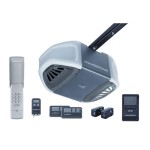Garage Door Opener Sizing Chart: Understanding Your Needs
Selecting the appropriate garage door opener is crucial for ensuring reliable and efficient operation of your garage door. A key aspect of this selection process involves understanding the sizing requirements based on several factors, including door weight, door type, and frequency of use. An undersized opener will be strained, leading to premature failure, while an oversized opener may be unnecessarily expensive and, in some cases, can be overkill for lighter doors. Therefore, a garage door opener sizing chart serves as a valuable tool in making an informed purchasing decision.
Garage door openers are generally categorized by horsepower (HP), which represents the motor's ability to lift and lower the door. Common horsepower ratings include 1/2 HP, 3/4 HP, 1 HP, and in some cases, even higher for very heavy or specialized doors. This article delves into the factors influencing the necessary horsepower, explains how to interpret a typical garage door opener sizing chart, and provides guidance on selecting the optimal opener for various garage door scenarios.
Key Factors Influencing Garage Door Opener Sizing
Several factors play a crucial role in determining the correct horsepower rating for a garage door opener. These factors include the garage door's weight, material, dimensions, and construction type, as well as the environmental conditions influencing operation.
Weight of the Garage Door: The weight of the garage door is the most significant determinant of the required horsepower. Heavier doors, naturally, require more power to lift and lower. Common materials for garage doors include steel, wood, aluminum, and combinations of these. Steel doors are often insulated, adding to their weight. Wood doors, particularly solid wood doors, are considerably heavier than steel or aluminum. Manufacturers typically specify the weight of their garage doors. If the weight is unknown, it can be estimated by referring to the door's specifications and type of construction or by consulting professional garage door installers.
Garage Door Material and Construction: The material and construction of the door directly impact its weight. Single-layer steel doors are lighter than insulated, multi-layer steel doors. Wood doors can vary significantly in weight depending on the type of wood used and their thickness. Aluminum doors are generally the lightest, but they may not be suitable for all climates or security needs. The construction type, such as whether the door is panelled, solid, or has windows, also influences the weight. Heavier, more robust constructions require more powerful openers.
Garage Door Dimensions: Standard garage door widths are typically 8, 9, 10, 16, or 18 feet. The height is generally 7 or 8 feet. Wider and taller doors naturally require more horsepower because they have a larger surface area and potentially, a greater weight. A double car garage door which is wider than a singe car garage door, for instance, often demands more power than a standard single car garage door.
Environmental Conditions: Environmental factors can also affect the performance of a garage door opener. In regions with extreme temperatures, the door may expand or contract, increasing friction and resistance to movement. Salt spray in coastal areas can corrode hardware, making the door heavier and harder to operate. Similarly, ice and snow accumulation in colder climates can add significant weight to the door, potentially overloading an undersized opener. These factors should be taken into consideration, potentially leading to the selection of a slightly more powerful opener than initially estimated.
Interpreting a Garage Door Opener Sizing Chart
A typical garage door opener sizing chart correlates garage door weight with the recommended horsepower. These charts are often provided by garage door opener manufacturers or found on websites specializing in garage door information. These charts typically present a series of weight ranges, each associated with a specific horsepower recommendation.
Understanding Weight Categories: Sizing charts usually categorize garage doors into different weight ranges. For instance, a chart might specify that doors weighing up to 300 pounds require a 1/2 HP opener, while doors weighing between 300 and 500 pounds need a 3/4 HP opener. Doors exceeding 500 pounds may necessitate a 1 HP opener or even a more powerful industrial-grade model. It is essential to accurately determine the weight of the door to properly utilize the chart.
Considerations Beyond Weight: While weight is the primary factor, the sizing chart should be interpreted in conjunction with other considerations. For example, a door weighing slightly less than 300 pounds might still benefit from a 3/4 HP opener if it is frequently used or made of a heavy material like solid wood. Similarly, if the door is subject to harsh environmental conditions, a slightly more powerful opener may be advisable to compensate for increased resistance.
Consulting Professionals: If there is any uncertainty about the weight of the door or the appropriate horsepower, consulting a professional garage door installer is highly recommended. Installers have the expertise and tools to accurately assess the door's weight and operating conditions, ensuring that the selected opener is adequately sized for the specific application. This investment can prevent premature wear and tear or even failure of the opener, leading to long-term cost savings.
Selecting the Optimal Garage Door Opener
Choosing the correct garage door opener involves more than just matching the door's weight to the horsepower rating on a sizing chart. Considerations such as the type of opener drive, frequency of use, and desired features should also be taken into account.
Type of Opener Drive: Garage door openers come in several drive system types, including chain drive, belt drive, screw drive, and direct drive. Chain drive openers are the most common and generally the most affordable. They are suitable for heavier doors but can be noisier than other types. Belt drive openers use a rubber or polyurethane belt to move the door. This results in quieter operation, making them ideal for garages attached to living spaces or near bedrooms. Screw drive openers use a threaded steel rod to move the door. They require minimal maintenance but can be affected by temperature changes. Direct drive openers attach directly to the door's torsion bar, minimizing moving parts and resulting in very quiet and reliable operation. The type of drive system should be selected based on budget, noise sensitivity, and desired maintenance level.
Frequency of Use: The frequency with which the garage door is opened and closed influences the required horsepower. If the door is opened and closed multiple times a day, particularly in a commercial setting or large household, a more powerful opener is recommended to withstand the increased workload. A 3/4 HP or 1 HP opener may be more suitable for high-frequency applications, even if the door's weight would theoretically allow for a 1/2 HP opener. Overworking an undersized opener can significantly reduce its lifespan.
Desired Features and Accessories: Modern garage door openers offer a wide range of features and accessories, such as smartphone connectivity, battery backup, and advanced safety sensors. These features can enhance convenience and security, but they may also place additional demands on the opener's motor. For example, a battery backup system ensures that the opener can function during power outages. A more robust opener may be advantageous to accommodate the additional electrical load of these features.
Oversizing Considerations: While undersizing a garage door opener can lead to premature failure, oversizing also has its drawbacks. A 1 HP opener, for example, may be more expensive and consume more energy than a 1/2 HP or 3/4 HP model. Furthermore, an excessively powerful opener could potentially damage a lightweight garage door if it operates too forcefully or without proper balance. It is generally best to select an opener that is appropriately sized for the specific door and its operating conditions, rather than opting for the most powerful model available. However, it's also important to note that selecting a slightly more powerful opener than theoretically needed provides a margin of safety and ensures smoother operation. A 3/4 HP motor, for example, will likely be operating less intensely than a 1/2 HP motor for any given garage door weight.
In addition to horsepower, the quality of the opener's components, such as the motor, gears, and drive mechanism, is crucial for long-term reliability. Choosing a reputable brand with a proven track record of quality and durability is essential. Reading customer reviews and comparing specifications can help in identifying reliable openers that will provide years of trouble-free service. Remember to factor in professional installation, which ensures proper alignment and operation. Improper installation can negate the benefits of even the most powerful and well-designed opener.

Garage Door Frame Size Chart From Brown Window Corporation

Garage Door Opener Styles In Plano Tx

How To Measure For A New Garage Door One Clear Choice
Garage Door Openers Service Appleton Green Bay Oshkosh Manitowoc Fond Du Lac Little Chute Wi Ez Glide

What Size Garage Door Opener Do I Need Horsepower Chart

Perfecting Garage Door Size Essential Guide For Homeowners

Standard Garage Door Sizes Single Double Roller Doors Sectional

Residential Garage Doors Available Sizes Garaga

How To Measure An Up Over Garage Door Online Doors

Standard Garage Door Sizes Single Double Roller Doors Sectional








